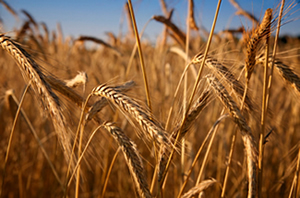Home > Home Milling > Types of Wheat
Wheat is the most important grain crop in the world. It is responsible for the development of the great bread-wheat civilizations from Mesopotamia to India, and China to Egypt, Greece and Rome, and then to our region.

Wheat is also the best grain for bread making. A kernel of wheat is known as the five-in-one; it is about 11 percent protein, and contains carbohydrates, both soluble and insoluble fiber, vitamins, and minerals. The less it is processed, the more nutritious it is.
Looking for grains to mill your own flour?
Select whole grains to mill your own flour
Wheat has two main growing cycles, Spring Wheat or Winter Wheat. These cycles, along with the region and soil content product soft and hard wheat, or wheat with a high starch content or high gluten content. The high amount of, or lack of gluten protein is what gives wheat flour its baking qualities.
Types of Wheat
In the United States, there are six predominate types of wheat.
Hard winter red wheat: This wheat is mostly grown in the Plains states as well as the northern states and Canada. It is a versatile wheat with excellent baking characteristics for pan bread. It is also used for Asian noodles, hard rolls, flat breads, general purpose flour and as an improver for blending. It is moderately high in protein (about 10.5%) which makes it good as an all-purpose or bread flour. About 40% of all of the wheat grown in the United States is hard winter red wheat.
Hard spring red wheat: This wheat is mostly grown in the northern states and Canada. It is considered the aristocrat of wheat when it comes to “designer” wheat foods like hearth breads, rolls, croissants, bagels and pizza crusts. It is also used as an improver in flour blends. It is one of the hardest wheats and therefore has one of the highest protein counts (13.5%). About 24% of the wheat grown in the United States is hard spring red wheat.
Soft winter red wheat: This wheat is mainly grown in the eastern states. It is a low protein wheat with excellent milling and baking characteristics for pan breads, general purpose flour and as an improver for blending. About 25% of the wheat grown in the United States is soft winter red wheat.
Hard winter white wheat: This is the newest class of U.S. wheat. It is sweeter and lighter in color that red wheat, with a protein profile similar to hard winter red wheat. It is great for making Asian noodles, whole wheat, pan breads and flat breads. Only about 1% of the wheat grown in the United States is hard winter white wheat, but it is gaining in popularity.
Soft spring white wheat: This type of wheat is generally grown in a few eastern states and in the Pacific Northwest and California. It is a low moisture wheat with high extraction rates that provides a whiter product for cakes and pastries. This variety is similar to soft winter red wheat with a slightly sweeter flavor. About 7% of the wheat grown in the United States is soft spring white wheat.
Durum wheat: This is the hardest of all wheats and has a rich amber color and high gluten content. The protein content ranges from 12.5 to as high as 17%. It sets the “gold standard” for premium pasta products, couscous and some Mediterranean breads. About 5% of the wheat grown worldwide is durum, but only about 3% of U.S. wheat is durum, mostly grown in North Dakota.
Within these different types of wheat, there are many varieties and substrains that offer an array of possibilities for millers as well as bakers. Bakers can choose between soft, low-protein cake and pastry flours, medium-protein all-purpose flours, and various degrees of hard, higher-protein bread flours.
There are different degrees of grind as well, such as coarse, medium, and fine. Other terms used to describe coarseness include: grits, groats, chops, cracked and meal.
You can find more information about these terms under baking terms.
Looking for grains to mill your own flour?
Select whole grains to mill your own flour.
Sources:
www.FLOUR.com
Hensperger, Beth. The Pleasure of Whole Grain Breads. 2000. Chronicle Books.
Ingram, Christine and Shapter, Jennie. Bread: The breads of the world and how to bake them at home.Hermes House 2006.
Reinhardt, Peter. Whole Grain Breads. Ten Speed Press. 2007.
U. S. Wheat Associates. “U. S. Wheat Classes.” Copyright 2005. http://www.uswheat.org/everyNeed/wheatClasses

Suzanne says
I have soft white winter wheat berries. Can I use this for yeast bread? Should I add gluten
Cathy says
Hi Suzanne, soft white winter wheat berries can be used for quick breads and biscuits but not really for yeast breads. Never tried adding gluten to this type of flour so not sure.
Jenn says
If I want to bake a sourdough bread with whole wheat flour and bread flour, what type of wheat berries should I use? Thanks
Cathy says
Typically, you’ll use hard red or white wheat berries to make whole wheat flour and mill it on the bread flour setting. You’ll need to sift out (extract) some of the bran and germ if you want a lighter bread flour.
Sheila says
Great information! We just started milling our own flour at home and what you wrote here is so helpful. I also have spelt berries, any tips for using the flour?
Cathy says
Hi Sheila, you’ll find some tips for working with spelt flour here https://www.breadexperience.com/spelt-bread.
Adrianna Moyes says
Whats a wheart berry here in aus we just call them grains
Cathy says
Hi Adrianna, there are different types of grains besides wheat. So wheat grains can be referred to as grains, wheat berries and whole grains.